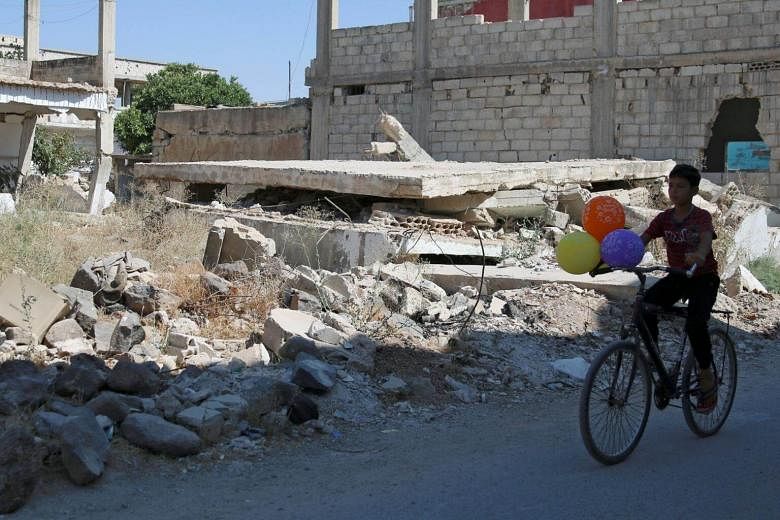LONDON (NYTIMES) - In an effort to purge extremist propaganda from its platform, YouTube has inadvertently removed thousands of videos that could be used to document atrocities in Syria, potentially jeopardizing future war crimes prosecutions, observers and rights advocates say.
"When the conflict in Syria started, independent media broke down and Syrians themselves have taken to YouTube to post news of the conflict," said Chris Woods, the director of Airwars, a London-based organisation that tracks international airstrikes and their effect on civilians.
"What's disappearing in front of our eyes is the history of this terrible war."
An unspecified number of individual videos and some YouTube channels were deleted in recent weeks after the company put in place new technology to automatically flag and remove content that potentially breached its guidelines.
Some videos were reinstated after their creators alerted YouTube.
The company previously relied on its users and a network of trusted monitors to report inappropriate material, which was then prioritised by an algorithm before being subjected to human review.
The new technology applies "machine learning" to identify and prioritize extremist videos for review. While most still undergo a human review before being removed, a YouTube spokeswoman said the technology might automatically remove videos and issue warnings to the content's creators.
The system was designed to identify videos posted by extremists groups, especially the Islamic State and its sympathisers, but any content from Syria and conflict zones where extremists operate risks being caught in YouTube's net.
"There are probably 200 or so civil-society organisations working on Syria alone," said Keith Hiatt, a vice president of Benetech, which provides tools for human rights investigations, and a board member of the International Criminal Court's technology advisory group.
"Some have risked their lives, others have given their lives to document the atrocities and document human rights violations."
If YouTube takes these videos down, Hiatt said, the platform risks losing "the richest source of information about human rights violations in closed societies."
Organisations that use such videos in their research regularly download copies and share them among themselves, but journalists and smaller groups do not have the same technical resources and therefore rely on YouTube to host the videos.
One group that monitors these videos is the International, Impartial and Independent Mechanism, a legal team established by the United Nations to collect and preserve evidence of crimes for use by courts and international tribunals.
"The IIIM will need to draw on social media and open source information when it's building cases that it will pass to prosecutorial teams," Hiatt said.
"Things just got a lot harder now the videos that were on YouTube are no longer around."
More than 6,000 videos documenting the Syrian conflict since 2014 were temporarily removed when YouTube shuttered the channel of the Qasioun News Agency, an activist media group with dozens of correspondents in Syria.
"Around one month ago we received strikes against all our channels - English, Kurdish and Arabic," Talal Kharrat, a manager with the agency, said in an interview. "The Arabic channel had our most subscribers and was deleted completely."
Airwars also had around a dozen of its videos temporarily removed, and at least five other channels belonging to Syrian opposition groups and the Syrian Ministry of Defense were deleted.
"Out of nowhere we received emails in quick succession that said that individual archived videos had been deemed to breach terms and conditions," Woods of Airwars said. "We were issued a formal warning and told if we had two more strikes our channel would be taken down."
YouTube's community guidelines stipulate that a channel can be removed for three violations of the platform's guidelines in a three-month period. The speed at which the new system is analyzing and issuing warnings on previously posted videos appears to be one reason some channels are being taken down without advance notice.
"From a warning to a channel being shut down happens in a short journey," Woods said.
While the new system appears to be correctly identifying graphic content like execution videos and Islamic State propaganda, it is mislabeling some videos. Three of the Airwars videos removed from its YouTube channel were aerial videos of airstrikes released by the Pentagon showing no graphic content.
Kharrat of the Qasioun News Agency said one of its videos had been cited for "spreading violence," even though it simply documented clashes between Syrian government forces and opposition groups.
Eliot Higgins, a journalist who founded the investigative website Bellingcat, said he had received an email warning about a video he uploaded in 2013, and a second notice for an edited video of the Islamic State's killing of the journalist James Foley that was not available publicly.
With 400 hours of video uploaded to YouTube every minute, a spokeswoman for the company said the new filtering technology was designed for scale and would improve with time. When it is brought to the site's attention that a video or channel has been removed mistakenly, she said, YouTube acts quickly to reinstate it.
Organizations worried that their content might be taken down are advised to provide context about the events in the online summary and metadata tags, and to be explicit about their intent in publishing these videos.

